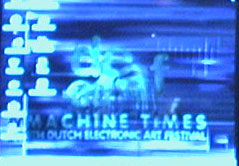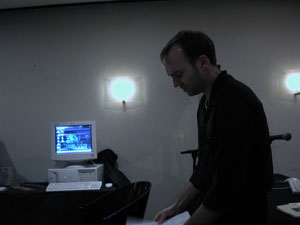|
|

|
||||||
|
|
|||||||
|
|
The Art of Selectiveness Perspectives on archiving online - a report on the workshop Digital Dive (DEAF 00) |
||||||
|
|
|||||||
|
|
|
|
|||||

|
|
||||||
|
|
|||||||
|
The internet appears, at times, to be the ultimate medium for the storage maniacs. Finally they can store the entire world on-line in a variety of digital formats and keep it continuously updated. But within the multitude of subjective opinions and personal and anecdoted archives, the authoritative voice seems lost. It is almost impossible to find such a voice on-line, and it seems equally impossible to make it heard. Personally I think that is a good thing, but it does leave a series of questions wide open when one starts to ponder the nature and possible uses of on-line archives. Should one opt to store everything and invest mainly in improved search techniques, or is the age-old fine trade of the archivist still a priceless profession? A lot of people are wondering what the use is of on-line archives if it cannot become the authoritative collection, if it is so hard to establish a worthwhile collection on-line (because it requires so much work), and if it is almost impossible to develop it commercially as long as the issues of intellectual property and copyright remain so wide open as they are today. Still, there is another breed of people who seem unfettered by these grim perspectives and untouched by the countless unresolved questions about in this field. The on-line archives of hyperlinked information sources is for them a fruitful terrain of exploration. Traditional hierarchies of information refinement can be challenged, unified perspectives left behind, and information processing can even be reinvented as a social or community based process. During the workshop at the Dutch Electronic Art Festival organised in November 2000 by V2_Organisation in Rotterdam, a group of representatives of this second category met to discuss their ventures into the universe of on-line archiving. The participants came primarily from an arts and culture background specialised in electronic and mediaart (including net-based art forms), but we had the honour of being accompanied by representatives of those professional trades one traditionally associates with the issue of archiving: librarians, photographic and audio-visual archivists and representatives of the museum world.
The two days of intense discussion led to a productive exchange of ideas and opinions about the state of affairs in the area of on-line databases, and how these can be applied and developed within a cultural context. The discussion showed clearly that a lot of the people present expect that an important part of future uses of the internet will revolve around or be supported by database-driven on-line media. The group tried to define some main areas of debate, and create a somewhat more visionary perspective than normally expected from the crafty archivist. Towards a poly-perspectivity Christian Hübler and Alexander Tuchacek of Knowbotic Research introduced their prototype for an evolving on-line database system based on the Flusser Archive, recently donated to the Academy of Media Arts in Cologne. The on-line version of the Flusser archive is still in an early stage of development. One of the main issues they are concerned with in the creation of this system is the potential of on-line databases to challenge the unified perspective on a database set. Instead, the on-line version of the Flusser archive should allow for multiple viewpoints (»poly-perspectivity«) on the same set of data, multiple selections of information from that data set, and novel user contributions to this set. This is an ambitious program, if the on-line archive is not to succumb to arbitrariness. The solution to prevent this problem is a rather surprising one. Instead of choosing a very complex and elaborate technical architecture, Hübler and Tuchacek propose to work with a social model, by creating an »invitation-network«. The idea is that researchers and other professionally involved users of the database create decentrally stored subsets of the data-set that act as local branches of a logical tree in the overall system. Once invited to the network these users can in turn invite other people to join and thus create new sub-branches within their own branch in the overall system. The crux of this approach is the social factor, which has to ensure that only people with a real and viable interest in the subject matter are invited to contribute to the architecture and content of the overall system. This approach would allow for a relatively simple technical architecture, which is open to new users / contributors and addition of new materials, while the dedication of the participants should prevent meaningless extensions of the system. Furthermore, the local sub-branching structure will allow for outside users to recognise the origin of certain local additions to the overall system and data-set. Each local branch then represents a local or personal viewpoint on the archive and its data set. Database construction as social practice
The notion of seeing database practice primarily as a social practice is even stronger in the example of In the case of Orang Orang the database is contributed to and maintained by a large group of users (app. 200), who are part of a rather closely knit community of musicians, sound artists, DJs, organisers and experimental radio makers. The database resides on several servers simultaneously, that automatically update each other via the smtp- protocoll. The system relies entirely on a local constituency, both in terms of the involvement of this local constituency to create and maintain the database, but also to validate the objects contained within it. During the following discussion it was asserted that many organisations and initiatives active in the field of connective networks have now discovered that a dedicated user base is an invaluable resource. This type of user-driven selection and classification could be called social filtering. In the case of »everything.com«, mentioned by Paul Perry, an on-line archive of everything is created. The users of the archive rate the individual contributions, so it is easy to see which entries are particularly popular or unpopular. A similar example of a user rating system are the reviews of books contributed by individual users at amazon.com. Important to note here is also that Orang Orang is not a deadarchive, or an archive of dead art objects. Instead it is created and continuously extended by a very lively community of (sound-) artists who use the database as a tool for living culture and contemporary cultural production, rather than an archive for preserving cultural heritage. The social dynamics of how the Orang Orang system is used sharply distinguishes itself from the systems mainly in view at the large-scale multimedia access cultural heritage programs that the EU promotes, such as the MEDICI framework. All is afloat…, the changing nature of technical standards An important recurring question for everyone involved with on-line archives and especially the archiving of on-line materials, or indeed on-line art works, is that of changing technical standards. The rightful lamentations of computer users and new media arts that they feel they have become slaves of updating already testifies to this. In the on-line world this problem is even more severe.
During the discussion of Should the objects themselves be archived or the meta-data? - in Rhizome's case the answer is: both! In some cases, for instance with the net.artist duo jodi.org, works are produced for a specific software standard. One work of jodi.org actually exploits an error in the 2.0 version of the Netscape web browser. What is archived in such cases? The work itself along with the viewing software, the work and the appropriate plug-ins? What about the hardware? Selection and identification The question of what to archive in a technical sense leads to the more general issue of selection. In much of the traditional arts and culture field the identity of cultural institutions and initiatives is not defined by their inclusiveness, but instead by their careful and critical selection. In the on-line world, however, everything seems to fall prone to the ideology of connectivity. It begs of the question in how far the seamless connection of on-line archives and databases is desirable at all in terms of definition of identity, meaning and context.
Obviously the idea of interconnection of archives and databases raises important technical questions. First of all there is the question of shared standards that would allow for »interoperability«. The next, even more complex, question is that of categorisation and standardised keywords for database indexes. The same term might mean different thing in different contexts: An important point raised in this discussion was that 'local' standards of meaning, within certain interest communities or geographies, should not be automatically rejected. There is in the end no universally correct description of an object and the fact that a specific description only communicates within a specific local context still does not disqualify the value of this description. »Local« in this context, obviously, can also relate to dispersed special interest communities. However, each community uses certain categorisations and terms to distinguish things from each other, musical styles and designations might be a very simple example, but these categories can be specific to one or a few highly particular music (sub-)cultures. Still for that 'local' group this categorisation makes a lot of sense, even though it might not be universal. Agents
Some discussion was spent on the use of intelligent agents as intermediaries for complex information systems and complex user requests. An example discussed was the proxy system ( Personalisation of data A final issue that should be mentioned is the personalisation of data. By filing user behaviour data within the database, a tailored service to users can be developed for recurring visitors to an on-line archive. This profiling of regular users is, however, not without privacy risks. The system amasses sensitive and highly specific personal information about the profiled users, which is valuable in marketing terms and has important privacy aspects. Therefore, a clear privacy policy, combined with a clear preference for anonymous systems above systems that identify individual users should be a common concern here. Some important on-line resources: Open-Source Software Projects:
Cultural networks involved in on-line archiving:
Library & museum related networks:
(Eric Kluitenberg, Amsterdam, Original report: December 5, 2000 / re-edit: March 20, 2001) With special thanks to V2_organisation, Rotterdam. |
|||||||









 Intro
Intro